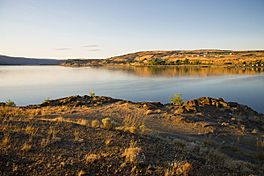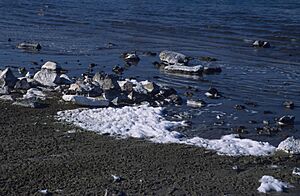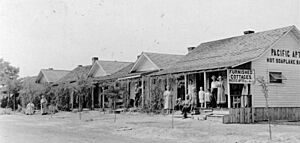Soap Lake facts for kids
Quick facts for kids Soap Lake |
|
|---|---|

View from the south shore of Soap Lake
|
|
| Location | Grant County, Washington, United States |
| Coordinates | 47°24′18″N 119°29′51″W / 47.405°N 119.4975°W |
| Type | meromictic |
| Basin countries | United States |
| Surface area | 2 sq mi (5.2 km2) |
Soap Lake is a special kind of lake in the town of Soap Lake, Washington. It was created by huge ancient floods called the Missoula Floods. The lake is known for its unique water, which feels a bit slick and soapy. This is because it's full of natural minerals. Sometimes, you can even see foam on the water, which is how it got its name! Soap Lake is about 2 square miles (5.2 km2) big and 70 feet (21 m) deep. It's also a "meromictic" lake, meaning its layers of water don't mix.
Contents
Amazing Qualities of Soap Lake
Soap Lake's water is packed with minerals. For a long time, people have believed these minerals could help with healing.
A Place for Healing
Stories say that different Native American tribes would stop fighting when they came to Soap Lake. They would visit the lake to relax and heal themselves and their animals. History books and old artifacts found in the area support these stories. In the 1920s, tourist guides in Washington State called Soap Lake the "world's greatest mineral sea." People even came to bathe in the lake, hoping it would help them feel better. Today, the town of Soap Lake calls itself "Washington's Health Resort."
What Makes the Water Special?
There are 23 different minerals in Soap Lake water! Scientists have been testing the water since 1910. They've found that the amount of minerals in the lake has gone down a bit over the years. The famous foam on the lake is also less common now. You usually only see it on windy days. This might be because of canals built to connect Soap Lake to other lakes and the Grand Coulee Dam.
Even with these changes, Soap Lake still has more different kinds of minerals than almost any other body of water on Earth. It even has more diverse minerals than the ocean!
Ichthyols and Buoyancy
Soap Lake water also contains something called ichthyols. This is an oil-like substance that people in Europe use to treat infections and scrapes. The ichthyols in Soap Lake probably come from tiny red shrimp. These shrimp live in the water and break down when they die.
Just like the Dead Sea, Soap Lake has so many minerals that its water is very buoyant. This means it's super easy to float in!
A Lake Like Jupiter's Moons?
The water in Soap Lake is very alkaline. This is similar to the conditions found on some of Jupiter's moons! Because of this, scientists from Central Washington University received a special grant in 2002. They studied Soap Lake to learn more about the possibility of life on Mars.
Minerals in Soap Lake Water
Here's a look at some of the minerals found in Soap Lake water as of the year 2000:
| Element | Milligrams/Liter |
|---|---|
| Sodium | 5760 |
| Bicarbonate | 2480 |
| Sulfate | 2540 |
| Carbonate | 3840 |
| Chloride | 2290 |
| Potassium | 504 |
| Organic nitrogen | 0.9 |
| Fluoride | 7.2 |
| Ortho-phosphate | 6.3 |
| Nitrate | 0.7 |
| Calcium | 2.5 |
| Magnesium | 2.9 |
The water also contains very small amounts (less than 0.01 milligrams per liter) of other elements. These include aluminum, iron, copper, rubidium, lithium, strontium, barium, chromium, lead, manganese, titanium, vanadium, and boron.





